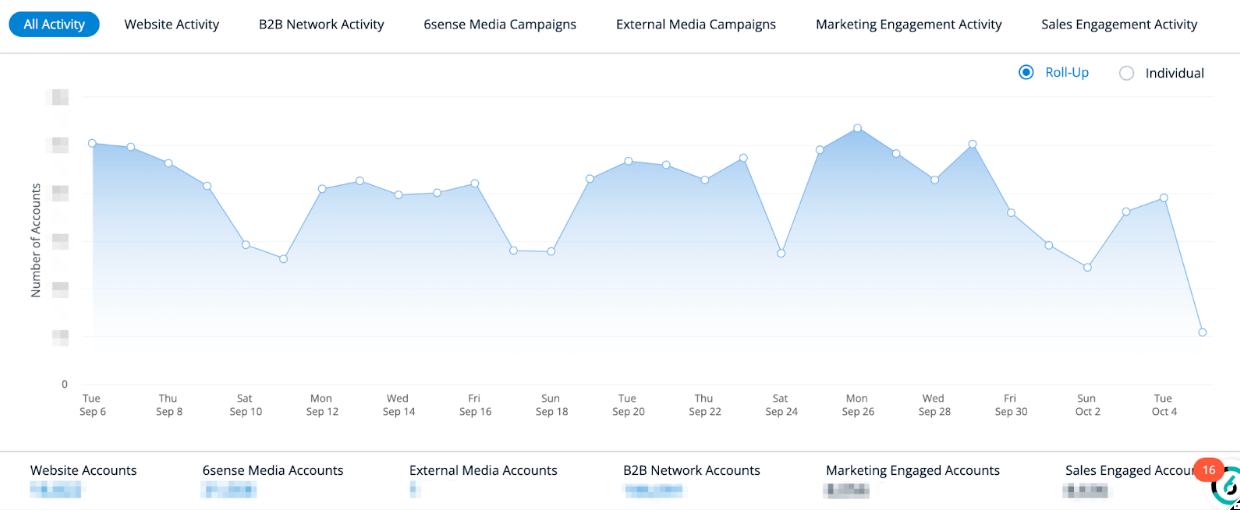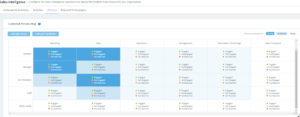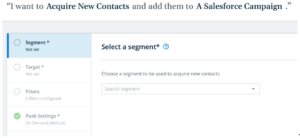You’ve decided to ditch the traditional lead-driven marketing playbook!
That’s great news, because as 6sense CMO Latané Conant writes in her book No Forms. No Spam. No Cold Calls, it’s time for marketing to stop focusing on marketing qualified leads (MQLs).
Instead, it’s time for marketers to focus on uncovering and targeting the accounts that are most likely to buy.
Uncovering buyers who are the right fit and also in-market requires marketing to build a strong foundation consisting of:
- A solid understanding of the companies that are the best fit for your business
- The ability to uncover early-stage signals buyers give off when beginning their journey
- The right metrics to measure overall performance
- Consistent messaging across every channel and segment
- A process to discover every member of the buying team
Let’s dive into how your marketing team can start finding opportunities using those tactics.
How to Reach the Right Audience
Finding Your Ideal Customer Profile
Once you’ve stopped focusing on indiscriminately capturing as many leads as possible, you need a new starting point for your marketing efforts.
Enter, the ideal customer profile (ICP).
Out there somewhere is your perfect customer. They grumble to themselves daily about the exact pain points you solve. The company they work for has the right amount of employees, number of locations, and can afford your services.
All of those qualities make for the ideal customer — someone your sales team would barely have to persuade before they signed on the bottom line.
Your ICP will take into account:
- Company size
- Industry
- Revenue
- Number of employees
- Tech stack
- Locations
You may already have an ICP that you use for marketing and sales, but if not, now is the time to build it. Ask sales which accounts are their dream fit. Go over past opportunities and deals with operations to look for similarities and differences.
With a strong ICP in place, you’ve now narrowed your focus. You can start tailoring your marketing campaigns to companies that fit the profile.
How to Find Which ICP Members are In-Market
Imagine you find the perfect account. They check every box and then some. The dollar signs are flashing in your eyes. It’s a layup; why wouldn’t they buy from you?
Then, after launching some killer campaigns and targeting this account, you hit a snag. They’re not actually in-market for a solution — because they have no budget, no awareness of a problem, or they’ve already signed with a competitor.
The key to finding success with your new marketing strategy is only to focus on customers that are an ideal fit and are looking for a solution.
This is called an In-Market Ideal Customer Profile (IICP).
Finding your ideal accounts that are in-market requires uncovering the signals buyers give off as they start their buying journey.
70% of the buying journey happens anonymously as buyers:
- Visit your website without filling out a form
- Search for topics related to their pain points
- Read third-party review sites
To find buyers during this stage you need to capture those buying signals and tie them to your list of target accounts. ICP = your wish list. IICP = your “very attainable” list.
How to Deliver Consistent, Engaging Messaging to your IICP
Once you’re able to identify the accounts that are a good fit and are in-market, it’s time to start engaging them with targeted marketing campaigns.
Because you know the accounts you’re targeting are a good fit, you need to be precise and accurate with your messaging. These buyers are smart and will only respond to messaging that clearly highlights your benefits.
To do this, create a value messaging framework that will inform everything you do. Here’s how.
Start with the priorities of your customers’ executives. What big problems does your business solve? Working from the top down, identify the priorities of the entire buying team.
Next, break out the priorities one-by-one and for each complete the following table:
| Current State | What is the customer’s current state? The pain points they see daily, and the negatives that come from not solving these problems. |
| Current State Risks | How will the challenge, if unaddressed, impact the ability to grow and compete? |
| Future State | What would it look like if your buyer could solve those issues? What does a perfect world look like for them? |
| Future State Rewards | The benefits that your buyer will see with your product/services. |
| Business Requirements | What does the buyer need to have in place to capture the value your solution can provide? |
| Executive Priority Metrics | What are the metrics that your solution will improve? Or what new metrics can your buyer unlock? |
| Conversation Starters | The questions that will lead a buyer toward identifying the challenges they face and the future state they’re aiming for. |
| Capabilities | The capabilities your product offers that directly address this need. |
| Use Cases | The different use cases your product has which align with this priority. |
| Customer Stories | A list of case studies and customers who have faced similar challenges, and how they overcame them with your help. |
With this framework in place you gain the following benefits:
- Aligned messaging across different teams
- A cohesive experience across multiple channels
- Consistent messaging for buyers throughout their journey
Whether you’re launching a digital advertising campaign or a new email nurture, your value messaging framework will serve as a strong foundation.
Measuring Marketing’s Impact at All Levels
Once you’ve designed some killer campaigns with messaging that will resonate with your in-market buyers, it’s time to launch them and measure their effectiveness.
Campaign Reach
The screenshot below shows the 6sense platform, and how users can quickly gain a high-level overview of the number of accounts engaging with your marketing efforts. Users can also quickly drill down into different channels like website activity or media campaigns.

This view provides a quick overview of the overall performance of your campaigns.
Campaign Interactions
This is a further breakdown of engagement, which could include:
- Opening or clicking through an email
- Engaging with a digital ad campaign
- Downloading an eBook
- Interacting with your brand on social media
This level of analysis helps clarify which of your campaigns and channels are creating the most engagement with your in-market buyers.
This screenshot from the 6sense platform shows a breakdown of engagement across various campaigns and channels:

Individual Engagement at Target Accounts
Modern buying teams are really large. Gartner finds there could be 14 to 23 people deciding whether they’re going to purchase your product. To help close a deal, you’ll want to engage as many members as possible.
The more varied interactions an individual has with your campaigns, the more likely they are to be a champion for your company.
In the 6sense platform, you can quickly see how much interaction you’ve had across an entire target account.

With this view you have a quick overview of your level of engagement by department and title — while also being able to dive deeper and see each individual’s activities.
How to Identify Which Accounts are Ready for Outreach
By combining the data that indicates an account is in-market with their level of engagement, it’s easier to identify the best candidates for further outreach.
A platform like 6sense that uses artificial intelligence (AI) to give you a real-time picture of where your buyers are in their journey:

Real-time data makes it clear which accounts are ready for further conversations with sales.
How to Deanonymize the Entire Buying Team
Because so much of the buying journey is anonymous, it’s crucial you find the buying team members as early as possible to influence them with your marketing campaigns.
To do that, you need a system in place that is regularly adding new contact information and enriching that data. 6sense makes this a possibility by allowing users to create an automated process for acquiring new accounts:

During the contact acquisition setup, you can use the persona map (shown earlier) to determine which contacts to prioritize. This makes it incredibly easy to fill the missing gaps for critical personas.
The Right Message to the Right Person at the Right Time
As you flesh out an account’s buying team by acquiring contacts, you can also sharpen your marketing by enrolling those contacts in different marketing campaigns based on their buyer persona.
These persona-specific campaigns will help you deepen engagement and get more members of the buying team excited. The more buying team members you engage, the more likely you will close a deal.
Conclusion
Ditching the traditional marketing playbook means shifting your thinking from driving leads through broad-based efforts to driving deals through focused campaigns that offer much more data.
Ultimately, it’s about harnessing technology to eliminate the uncertainty that clouds progress for marketing and sales teams. With a clearer picture of who is in-market, what they want, and when they want it, you can seize more opportunities and win more deals.



